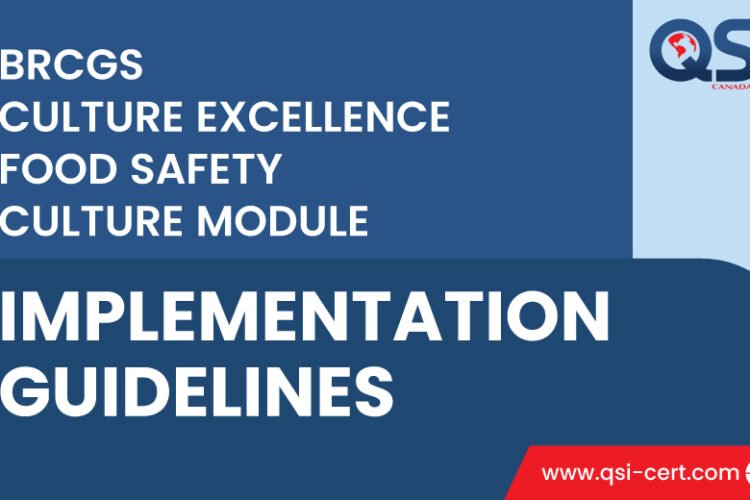
What is BRCGS?
BRCGS, formerly known as the British Retail Consortium Global Standards, is a leading brand and consumer protection organization. It sets the benchmark for best practices in the food and beverage industry, ensuring the quality and safety of products worldwide.
The Benefits of BRCGS on Food Safety and Human Health
BRCGS certification is more than a mere compliance tick mark; it’s a comprehensive approach to managing product safety, integrity, legality, and quality. Here are some of the key benefits :
- Enhanced Food Safety: BRCGS standards improve food safety management systems, leading to safer food for consumers.
- Operational Efficiency: Certified organizations often see improved operational practices, which can lead to fewer errors and reduced waste.
- Commercial Growth: Compliance with BRCGS standards can open new market opportunities and increase consumer trust.
- Improved Profitability: By streamlining processes and reducing the costs of failure, BRCGS can positively impact the bottom line.
- Innovation: The framework encourages innovation in food safety practices, keeping certified companies at the forefront of the industry.
The Impact of BRCGS Certification on Today’s Food
The BRCGS certification program has significantly influenced the food industry by setting a global standard for food safety and quality. The certification:
- Drives Competitiveness: Encourages investment and modernization, which in turn increases competitiveness in the global market.
- Ensures Quality: Provides a framework that helps businesses manage the quality and safety of their food products effectively.
- Builds Consumer Confidence: The BRCGS mark assures consumers of the product’s safety and quality, influencing purchasing decisions.
The Scope of BRCGS Certification
The scope of BRCGS certification is broad, covering various aspects of the food industry, from manufacturing to storage and distribution. It ensures that all parts of the supply chain are adhering to the highest standards of quality and safety. The certification process includes a rigorous audit that assesses a company’s adherence to the BRCGS standards, which are globally recognized and benchmarked by the Global Food Safety Initiative (GFSI).
In conclusion, BRCGS plays a pivotal role in shaping the food industry by promoting best practices that benefit both businesses and consumers. Its comprehensive standards and certification process make it a cornerstone of global food safety and health.
What’s new for BRCGS Food 9?
Compared to its predecessor, Issue 9 of the BRCGS Food Standard contains a number of significant changes. According to BRCGS, the new issue emphasizes key subjects to ensure global applicability of the Standard. Several new clauses have been added to the key areas listed below:
- Integration of the benchmark requirements of the Global Food Safety Initiative (GFSI 2020)
- Clear requirements to implement and comply with relevant legislation
- Detailed requirements to develop a food safety culture
- Revision of the section food safety plan to align with the Codex Alimentarius aspect Validation
- Clear and detailed requirements for outsourced processing
- Extending the food defence and food fraud requirements
- Detailed requirements for operational sites manufacturing pet foods for domestic animals and animal feed
- New section with requirements for sites completing animal primary conversion (e.g. for red meat, poultry or fish), (such as slaughterhouses or fisheries)
- Mandatory unannounced audit every 3 years
- Re-introduction of the blended announced audit option for recertifications consisting of a remote audit, followed by an on-site audit.
Key changes to the requirements for Issue 9 compared to Issue 8
These changes, listed in order of sections 1 to 9, are listed below. The requirements in Sections 1 through 7 apply to all process steps, with the following exceptions:
- 5.8 applies only to sites manufacturing, processing or packing pet food or animal feed
- 5.9 applies only to animal primary conversion (such as slaughterhouses or fisheries)
- 8 applies only to high-risk, high-care or ambient high-care production facilities
- 9 applies only to traded products, this is a voluntary section
Section 1: Senior management commitment
1.1.2 Food Safety and quality culture
Following the introduction and initial implementation of food safety culture in Issue 8, the focus in this new issue continues to be on achieving positive culture change within a company. The objective of the standard is to promote behavioural changes necessary to improve the culture. This refers in particular to the awareness of the employees at a site with regard to product safety activities and compliance. There is a requirement that the site shall have a plan to maintain and develop the product safety and quality culture within the site. Clause 1.1.2 of the BRCGS Food 9 Standard defines examples of such activities:1.1.2 The site’s senior management shall define and maintain a clear plan for the development and continuing improvement of a food safety and quality culture. The plan shall include measures needed to achieve a positive culture change.This shall include:
- defined activities involving all sections of the site that have an impact on product safety. As a minimum, these activities shall be designed around:
– clear and open communication on product safety
– training
– feedback from employees
– the behaviours required to maintain and improve product safety processes performance measurement of activities related to the safety, authenticity, legality and quality of products
- an action plan indicating how the activities will be undertaken and measured, and the intended timescales
- a review of the effectiveness of completed activities.
The plan shall be reviewed and updated at least annually, at a minimum.
Section 2: Food Safety Plan – HACCP
HACCP principles of the current Codex Alimentarius impacted the revision of some clauses in the new issue. Sites are recommended to avoid multiple plans with different terminology, but it is not necessary to adopt the Standard’s terminology.
2.7.4 Where the control of a specific food safety hazard is achieved through prerequisite programmes (see section 2.2) or control measures other than critical control points (CCPs; see clause 2.8.1), this shall be stated and the adequacy of the programme to control the specific hazard validated
This clause only requires validating the specific prerequisite programmes for minimising or eliminating a specific hazard (in ISO 22000 operational PRPs). For example, cleaning up allergen cross-contamination (clause 5.3.8) or ensuring adequate cold storage temperature also during stocking and full storage in order to prevent the risk of bacterial growth. All other prerequisite programmes, such as pest control, staff hygiene or training are not included, neither is general floor or wall cleaning.
The requirements under 2.12 for “Validate the HACCP plan and establish verification procedures” (equivalent to Codex Alimentarius Step 11, Principle 6) are new. This new requirement reflects the recommendation from Codex Alimentarius General Principles of Food Safety for the validation of food safety controls. Changes to the HACCP or food safety plans which may affect product safety, shall be checked to ensure they effectively control the identified hazard before implementation.
Section 3: Food safety and the quality management system
3.4 Internal audits: Under clause 1.1.4 “Management review meetings”, the management review calls for results from internal audits, but they are not described in detail. The management review entry required here is the review of the summary of action plan results arising during internal audits. This applies not only to internal audits, but also to the programme of documented inspections or hygiene or site inspections.
3.5.4 Outsourced processing: New requirements have been added to ensure that outsourced processes are considered in a site’s HACCP plan and requirements are agreed and recorded in a specification. The definition of outsourced processing was clearly and in detail presented in a comprehensive statement of intent It is important that food safety is maintained throughout the outsourced production process.
The root cause analysis required in section 3.7 Corrective and preventive actions has been clarified to ensure a consistent approach and to provide better linkage with other sections for continuous improvement.
Section 4: Site standards
4.2 Food defence: This section lists food defence requirements. These requirements primarily call for a risk assessment of potential risks from deliberate contamination at the site. However, the risk assessment can also be combined with the requirements of section 5.4 Product authenticity, claims and chain of custody, which evaluates the adulteration of raw materials outside the site (food fraud).
For hygiene, the focus has been placed on equipment with regard to the most common non-conformities. Several other standards and best practice guidelines provide detailed recommendations for hygienic equipment and devices. Section 4.6 Equipment has therefore been completely revised to align with current good practice:
- Considering hygiene when purchasing new equipment or equipment that is new to the site.
- Requirement for mobile equipment
- Equipment design and its suitability for use in food production, commonly referred to as ‘hygienic design’, has evolved significantly since the publication of Issue 8.
- equipment purchase: new, refurbished, used equipment
- new clauses for installation (or commissioning)
- new clauses for mobile and static equipment
Section 5: Product control
5.4.7 The new requirement to validate product claims on labels has been added here .The numbering under section 5.6 Product inspection, on-site product testing and laboratory analysis has changed, the contents of the clauses from issue 8 have been slightly adjusted.
5.8 Pet food and animal feed requirements
Here the title has been clarified, instead of animal feed in version 8 the clause now refers to pet food and animal feed. New requirements have been established for manufacturers.
New clause 5.9 Animal primary conversion
Where a site completes animal primary conversion or meat processing (e.g. for red meat, poultry or fish), specific controls are required to ensure that the food is safe and fit for its intended use during animal processing.
Section 6.1 Control of operations
There is a new clause in this section requiring that e.g. by-products outside the scope of the audit do not compromise the safety of the audited products.
Section 7.4 Protective clothing
7.4.3 Issue 8 stated “testing the effectiveness of cleaning”, now a “validation of the effectiveness of cleaning” is required.
Section 8 Production risk zones – high risk, high care and ambient high care
new 8.2.3 Requirements for removable walls in high-risk or high-care areas.
new 8.5.4 CIP equipment shall be used either for designated areas only (separate systems for high-risk, high-care and other production areas) or with control systems if used in all areas.
8.7.1 Issue 8 stated “testing the effectiveness of cleaning”, now a ” validation of the effectiveness of cleaning” is required
Section 9: Requirements for traded products
This requirement allows the audit to include the handling of products that usually are within the scope of the standard and stored at the site, but not manufactured, processed, packaged or labelled there. The company shall establish procedures to ensure that the finished product is safe, complies with legal requirements and has been manufactured in accordance with the product specifications. This section 9 remains voluntary.
New section 9.1 The Food Safety Plan – HACCP with a separate traded product or a traded product integrated into the existing HACCP Plan on goods receipt, storage and dispatch is placed before the already existing sections of issue 8, with the remaining sections being given a higher numbering level.
Contact us to learn more about how BRCGS can benefit your business.
I hope this blog post provides a clear overview of BRCGS and its importance in the food industry. If you need further details or have specific questions, feel free to ask!


